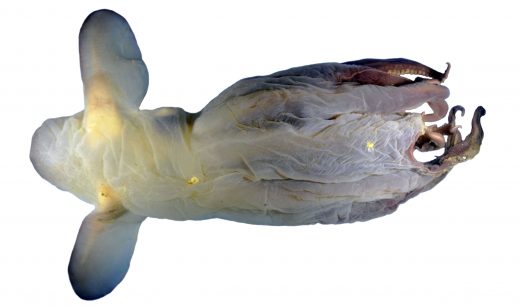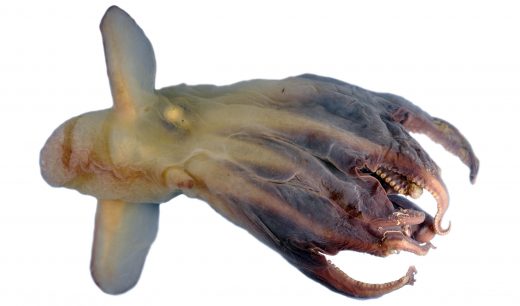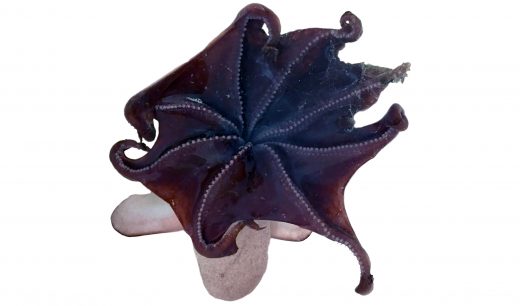Seeing Inside the Newly Discovered Emperor Dumbo Octopus
The discovery of the emperor Dumbo octopus stemmed from the use of nondestructive MRI and CT scans—techniques that could revolutionize taxonomy.
Article body copy
The first time Alexander Ziegler saw the octopus he would go on to call Grimpoteuthis imperator, it was tangled in a steel net on the deck of a research vessel in the North Pacific Ocean, having just been hauled up from a depth of more than 4,000 meters.
The first time he really saw the octopus, it was on his computer screen, where the arches of its blood vessels and the folds of its gills—illuminated in exquisite digital detail—were poised to shake up the tradition-bound field of taxonomy.
Five summers ago, Ziegler, an evolutionary biologist at the University of Bonn in Germany, was the lone biologist tagging along on an expedition collecting rocks from the depths of the Pacific to gain insights into plate tectonics. Ziegler had been invited to deal with the life forms the geologists inevitably scraped up with the rocks they sought.
At first glance, the haul on that July day in 2016 seemed unpromising: not even many rocks to speak of. Then Ziegler spied the octopus, a pinkish lump.
The creature was about the size of a human head and had eight webbed arms. The pair of fins on the side of its body clearly marked it as a Dumbo octopus—so-called because the fins resemble the oversized ears of Disney’s cartoon elephant.
Ziegler is a sea urchin specialist, but he knew he was looking at something noteworthy. Given how far the ship was from where other Dumbo octopuses are known to live in the Pacific, he suspected this was a species new to science. So he photographed the octopus and measured various anatomical features, including its suckers and the webbing between its arms. He snipped a small tissue sample from a damaged arm tip for DNA analysis, and preserved the entire specimen in formaldehyde.
But once he was off the ship and back in Germany, Ziegler did something unusual: he put the octopus in an MRI, and used a CT scanner to look at its eyes and hard beak.
The emperor Dumbo is the first large organism ever fully described using nondestructive methods. Photos by Alexander Ziegler
Identifying a new octopus species is a many-armed endeavor that depends on carefully assessing a suite of internal and external characteristics. Everything from the length of the octopus’s arms and the number of suckers on each, to the arrangement of its optic nerves and the shape of its gills must be taken into account. Analyzing all of this and more showed that the pink octopus is a new species in the genus Grimpoteuthis. Ziegler and his colleague Christina Sagorny, a graduate student at the University of Bonn, dubbed it Grimpoteuthis imperator—emperor Dumbo—after the Emperor Seamounts, the underwater mountain range off Japan where it was collected.
The way in which Ziegler assessed the emperor Dumbo is a sharp departure from the way in which a new species is typically described—by taking it apart. Traditionally, a taxonomist identifies a new octopus by flipping it on its back, cutting open its mantle, and removing and measuring its internal organs one by one. To reveal the structure of the beak, the muscles around the mouth are dissolved with chemicals.
There are obvious flaws with this process. “When you open up a specimen, even if you do it very carefully, you basically destroy its structural integrity,” Ziegler says. This can result in a misleading picture of a specimen’s features, and means researchers can’t go back and reexamine it with improved techniques in the future. Ziegler argues that nonintrusive imaging more accurately captures the nuances of internal anatomy.
Yet this is the first time such a large animal has been described through largely noninvasive methods. “The use of the 3D imaging without dissection is a very useful concept,” says Michael Vecchione, a cephalopod specialist at the Smithsonian Institution in Washington, DC, who was not involved in the work. “Even though the techniques have been around medically for a while, they’re just now finding their way into research on animals like invertebrates.”
The approach opens up the possibility of investigating the myriad oddities held in natural history collections around the world, Ziegler says, where, paradoxically, the rarest specimens are often the least likely to be studied. Taxonomists shy away from using destructive techniques on rare specimens, and curators are loath to permit it. Without imaging, Ziegler says, there would be no emperor Dumbo: “I would not have dared to cut it up.”
Studying new species noninvasively will be especially important for getting a handle on the denizens of the deep sea because spotty sampling—and the fact that many species are rare and sparsely distributed—means that specimens tend to be scarce.
Still, it will take time for biologists to work through the taxonomic backlog housed in museums around the world because scanners are expensive and aren’t widely available to taxonomists. Vecchione, for instance, suspects that a Dumbo octopus that he collected a few years ago from the South Sandwich Trench near Antarctica represents another new species; he’s waiting for a turn to examine it in the Smithsonian’s new CT machine.
Then there’s the matter of interpreting imaging data. “It is absolutely wrong to say that you could simply scan [all the specimens in] the museum and you’d know the new species,” says Adam Summers, a biologist at the University of Washington’s Friday Harbor Laboratories, who was not involved in the work. “You need taxonomic expertise in order to describe new things.”
The emperor Dumbo’s fate illustrates both the promise and the challenge of imaging techniques. The specimen’s final home will be on a shelf at the Museum für Naturkunde in Berlin, Germany, along with hundreds of specimens of deep-sea sponges, corals, crustaceans, echinoderms, and other animals collected on the same research cruise. As far as Ziegler knows, the octopus is the only one that has been investigated in detail.





